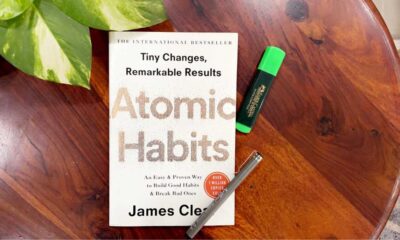Lifestyle
How To Stay Fit in A Busy Schedule

How tough it can be to stay fit and healthy when you’re juggling a busy schedule, but it’s not impossible! Here are a few tips help you to stay fit in a busy schedule.
The World Health Organization recommends that persons ages 18 to 64 engage in at least 150 minutes of weekly moderate-intensity aerobic exercise, or 30 minutes, five days a week.
According to the report, physical activity involves attending the gym and domestic duties, sports, organized exercise, and other activities like walking, dancing, gardening, hiking, and swimming.
But the crucial issue still exists: how can I fit 30 minutes of exercise into a hectic schedule?
Who wouldn’t be tempted to go home after a long day and watch TV? You might be surprised to learn that you don’t have to give up your screen time or any other activity if you follow the following advice if your busy lifestyle prevents you from exercising because you have commitments to go to the store, attend a language class, meet a friend for dinner, or finish your English paper.
Why working out lowers stress for a better work-life balance?
When considering how to fit exercise into a hectic schedule, most people are unaware that even five minutes of aerobic activity can have anti-anxiety effects.
But how does physical activity lower stress? Most of these advantages are brought about by improved blood flow to the brain and muscles and the production of endorphins, which improve mood, well-being, and productivity.
By boosting immunity and easing both physical and emotional tension, exercise can help lower stress. Exercise reportedly positively affects mood, sleep quality, metabolism, and energy levels throughout the day.
Exercise is the best method to maintain good mental health when working from home. But, incorporating exercise into a busy schedule is more than a nice idea.
It is extremely necessary to tackle the epidemic of stress that we are all currently experiencing. To combat this public health problem, find little moments throughout the day to relax and prioritize your health.
Many factors might cause stress. Stress can affect almost every part of our life before, during, and after work, from deadline stress to health-related worry to shifting family dynamics. Persistent stress can cause disease, trouble concentrating, and priority confusion.
The good news is that you can lessen the impacts of concern without committing to daily 60-minute fitness sessions.
These two powerful yoga practices can work magic for lowering stress and learning how to integrate fitness into a hectic schedule.
- Breathing-focused meditation
Place your feet firmly on the ground, sit comfortably, lengthen your spine, close your eyes, relax your shoulders and face, focus within, and pay attention to your breathing, including where it goes and how it feels.
During five to ten minutes, keep your attention on your breathing and let your body inhale and exhale naturally.
- Death Posture
Working slowly from the top down your toes, ask each major muscle group to let go as you take a calm, deep breath. Lie on your back with your legs extended straight forward and your arms at your sides.
Related: 50+ Health benefits of yoga
Ways to stay fit in a busy schedule:
1. Schedule a brief workout
You can always plan a short training session before work if you feel your day is too full to fit in any time for exercise. A quick workout of 30 minutes in the morning can work wonders; it will improve your mood and keep you up and attentive for the rest of the day.
If you’re not a morning person, you can exercise in the evening. Spending a little time working out will keep you happy and healthy (and let you eat a piece of that tempting brownie your colleague brought to work guilt-free).
2. During breaks, do stretching or go for a walk
You can do a few exercises while working to keep your body moving and schedule time for exercise outside of work. Make sure to take short breaks to stretch your muscles and keep your body moving if your job demands you to sit at a desk all day.
Take a little stroll around the workplace when you’re taking a break or on a call. It can help you stay active and healthy.
3. Eat Healthy Meal
Staying fit involves more than just exercise; it also involves eating healthfully. It might be challenging to prioritize your diet when you have a busy schedule. Although ordering takeout is undoubtedly more convenient, all that grease is unhealthy and can slow you.
You’ll stay active and better concentrate on your task if you eat a well-balanced meal at the appropriate time.
4. Cycle or Walk to Work
You can walk or bike to work if you are fortunate enough to live close to your place of employment. You should walk or ride your bike to work to keep yourself in shape, feel well, and be more attentive throughout the day.
By lowering your carbon footprint and burning calories in the process, you also benefit the earth. It benefits everyone.
How to create a work-friendly fitness schedule?
Making an exercise plan around your schedule is simple to learn but difficult to maintain over time. Examine your present routines carefully before work, throughout breaks, and immediately after you clock in or out.
Exercise should replace undesirable habits like reading through social media or responding to work emails after hours. Next, consider if you naturally have more energy in the morning or the evening.
Review your workout goals next, consider whether they are feasible given your current schedule and level of energy, and make any necessary adjustments.
Starting modestly and making a long-term plan is preferable to going all out now and giving up later.
Next, be sure to mark a certain day and time for your fitness regimen in your planner or calendar. Finally, make a backup plan by listing all the potential obstacles to your goal achievement. Before the obstacles arise, list what you can do to help.
For instance, if you believe you will lose motivation in a few weeks, ask a friend to phone you on a certain day and inquire about your workout regimen.
How to work out every day at home?
Dumbbells and a yoga mat should be kept close at hand as exercise equipment. Inform your family or roommates that you will be inaccessible at a particular time and date since you will be working out in a different room. Alternatively, you could ask them to participate in the fun!
Moreover, make a playlist of your favorite YouTube fitness videos, so you always have something to look forward to. Take a physical interest, like tennis or gardening, to help you relax and get in your weekly exercises.
You probably already gathered that preparation is the key to learning to work out regularly at home. Prepare in advance by laying out your equipment, identifying exercises you’re eager to do, and selecting activities you like.
Related: 8 Golden rules of fitness
Exercise Ideas for Weight Loss
Beyond simply adding muscle, there are other strategies to lose weight. While adding muscle is quicker, maintaining that muscle is equally necessary. Long periods missed from training can be harmful.
Fortunately, concentrating more on workouts specifically designed to help you lose weight is an option to consider. The advantage of these activities, similar to muscle-focused routines, is that you concentrate on the movements that burn more fat while enhancing your general endurance.
Cardio workouts like jogging, walking, sprinting, or riding (on a machine or outside) and HIIT is popular (High-Intensity Interval Training).
For those who are unfamiliar, HIIT is a set of high-intensity exercises that are performed in intervals. It indicates that you are exercising in brief spurts over some time. Consider performing multiple jumping jacks followed by a series of sit-ups, a brief pause, and then continuing the same or other exercises once more.
Do These Exercise for Building Muscle
We use our muscles daily to move, lift, push, pull, and do other tasks. Building up our muscles is incredibly beneficial because they are crucial to our daily function.
Even if you lead a sedentary lifestyle, developing stronger muscles is crucial because they help maintain good posture and prevent age-related body aches and pains.
Instead of worrying about your rep count, muscle-building workouts place more emphasis on harder lifting exercises. It is ideal for performing these exercises with a trainer or someone with knowledge in muscle-building since they can direct and spot you while you work out, preventing overexertion.
It is advantageous because the activities you’ll be performing involve lifting, tugging, and swinging. Some of the workouts you could perform include bench presses, deadlifts, kettlebell swings, squats, rear delt flys, and general strength training.
Depending on those goals, there are many ways exercising on particular muscle groups can help you achieve them. Muscle exercises, for instance, can benefit from the following:
Losing weight because fat and calories are needed for muscle growth. Strengthening your muscles will cause them to consume fat accumulation naturally.
Training particular muscles can also guarantee that those muscles will be able to hold you in a particular position and support you. For instance, developing back muscles can result in a straight spine when seated. By doing this, you can prevent back pain in the future.
As stated, exercising your muscles with a partner, especially one who can watch you and instruct you on the perfect form, is wiser. But there are some other suggestions to take into account:
- Establish goals before beginning. It takes time to develop the body of your dreams, and it won’t happen in three months.
- Your genetic makeup and work ethic are the two main aspects that will make it easier for you to grow muscle and lose weight. An Olympic athlete will therefore have an advantage over a passive person in gaining muscle and burning fat.
- You should focus more on your protein intake than your calorie intake if you want to gain muscle. It’s not unusual for people gaining muscle to consume 100 grams or more protein daily.
- Keep in mind that protein is not always found in meat. Drinking protein smoothies throughout the day can satisfy a significant amount of the recommended daily protein intake.
With a hectic work schedule, how can I commit to exercising?
Decide why you want to accomplish this goal, where it ranks on your list of priorities, and what you are ready to give up. It is the greatest method to learn how to commit to working out. Also, identify your motivators and put them to good use.
If you discover that you are driven by feedback from others, find an exercise partner or accountability partner. Make a list of the treat you’ll buy for yourself when you’ve completed your monthly training schedule if you prefer material incentives.
Takeaway
Consider this: you’ll always come up with justifications for not exercising. If you don’t think you have 30 minutes to commit to exercise, keep in mind that you can always divide the time up throughout the day, giving you time to meet deadlines, spend time with friends, answer the phone, and stick to your original plans.
It won’t take long for it to become a regular occurrence in your life!
-

 Books3 months ago
Books3 months ago10 Life-Changing Lessons from ‘Atomic Habits’ by James Clear
-

 Growth3 months ago
Growth3 months agoThe Hero’s Journey: Transformative Questions for Success?
-

 Growth2 months ago
Growth2 months agoSimple Ways To Boost Your Confidence In A Day
-

 Growth3 months ago
Growth3 months agoHow Cognitive Biases Affect Our Decision-Making Process
-

 Travel3 months ago
Travel3 months agoMindset Peaks: The Mental Benefits of Trekking Explained
-

 Mental Health3 months ago
Mental Health3 months agoWhat Are the Mental Health Problems Among Adolescents?
-

 Quotes3 months ago
Quotes3 months ago40 Best Swami Vivekananda Quotes On Motivation, Love and Life
-

 Mental Health3 months ago
Mental Health3 months agoWhat Are the Most Common Mental Health Issues in Young Adults?




















